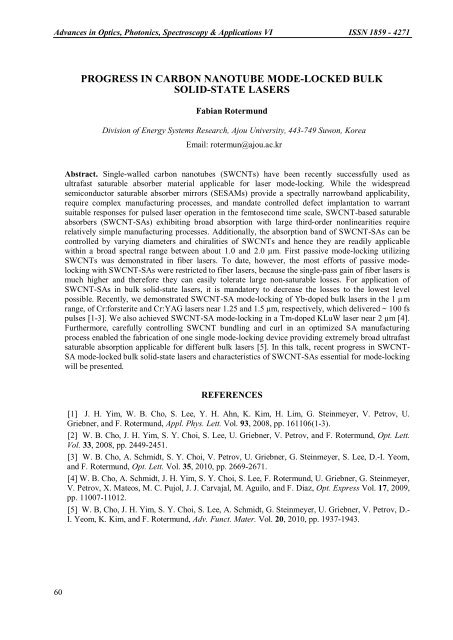Advances in Optics, Photonics, Spectroscopy & Applications <strong>VI</strong> <strong>ISSN</strong> <strong>1859</strong> - <strong>4271</strong>PROGRESS IN CARBON NANOTUBE MODE-LOCKED BULKSOLID-STATE LASERSFabian RotermundDivision of Energy Systems Research, Ajou University, 443-749 Suwon, KoreaEmail: rotermun@ajou.ac.krAbstract. Si<strong>ng</strong>le-walled carbon nanotubes (SWCNTs) have been recently successfully used asultrafast saturable absorber material applicable for laser mode-locki<strong>ng</strong>. While the widespreadsemiconductor saturable absorber mirrors (SESAMs) provide a spectrally narrowband applicability,require complex manufacturi<strong>ng</strong> processes, and mandate controlled defect implantation to warrantsuitable responses for pulsed laser operation in the femtosecond time scale, SWCNT-based saturableabsorbers (SWCNT-SAs) exhibi<s<stro<strong>ng</strong>>tro<strong>ng</strong></stro<strong>ng</strong>>>tin</s<stro<strong>ng</strong>>tro<strong>ng</strong></stro<strong>ng</strong>>>g broad absorption with large third-order nonlinearities requirerelatively simple manufacturi<strong>ng</strong> processes. Additionally, the absorption band of SWCNT-SAs can becontrolled by varyi<strong>ng</strong> diameters and chiralities of SWCNTs and hence they are readily applicablewithin a broad spectral ra<strong>ng</strong>e between about 1.0 and 2.0 μm. First passive mode-locki<strong>ng</strong> utilizi<strong>ng</strong>SWCNTs was demonstrated in fiber lasers. To date, however, the most efforts of passive modelocki<strong>ng</strong>with SWCNT-SAs were restricted to fiber lasers, because the si<strong>ng</strong>le-pass gain of fiber lasers ismuch higher and therefore they can easily tolerate large non-saturable losses. For application ofSWCNT-SAs in bulk solid-state lasers, it is mandatory to decrease the losses to the lowest levelpossible. Recently, we demonstrated SWCNT-SA mode-locki<strong>ng</strong> of Yb-doped bulk lasers in the 1 µmra<strong>ng</strong>e, of Cr:forsterite and Cr:YAG lasers near 1.25 and 1.5 μm, respectively, which delivered ~ 100 fspulses [1-3]. We also achieved SWCNT-SA mode-locki<strong>ng</strong> in a Tm-doped KLuW laser near 2 μm [4].Furthermore, carefully controlli<strong>ng</strong> SWCNT bundli<strong>ng</strong> and curl in an optimized SA manufacturi<strong>ng</strong>process enabled the fabrication of one si<strong>ng</strong>le mode-locki<strong>ng</strong> device providi<strong>ng</strong> extremely broad ultrafastsaturable absorption applicable for different bulk lasers [5]. In this talk, recent progress in SWCNT-SA mode-locked bulk solid-state lasers and characteristics of SWCNT-SAs essential for mode-locki<strong>ng</strong>will be presented.REFERENCES[1] J. H. Yim, W. B. Cho, S. Lee, Y. H. Ahn, K. Kim, H. Lim, G. Steinmeyer, V. Petrov, U.Griebner, and F. Rotermund, Appl. Phys. Lett. Vol. 93, 2008, pp. 161106(1-3).[2] W. B. Cho, J. H. Yim, S. Y. Choi, S. Lee, U. Griebner, V. Petrov, and F. Rotermund, Opt. Lett.Vol. 33, 2008, pp. 2449-2451.[3] W. B. Cho, A. Schmidt, S. Y. Choi, V. Petrov, U. Griebner, G. Steinmeyer, S. Lee, D.-I. Yeom,and F. Rotermund, Opt. Lett. Vol. 35, 2010, pp. 2669-2671.[4] W. B. Cho, A. Schmidt, J. H. Yim, S. Y. Choi, S. Lee, F. Rotermund, U. Griebner, G. Steinmeyer,V. Petrov, X. Mateos, M. C. Pujol, J. J. Carvajal, M. Aguilo, and F. Diaz, Opt. Express Vol. 17, 2009,pp. 11007-11012.[5] W. B, Cho, J. H. Yim, S. Y. Choi, S. Lee, A. Schmidt, G. Steinmeyer, U. Griebner, V. Petrov, D.-I. Yeom, K. Kim, and F. Rotermund, Adv. Funct. Mater. Vol. 20, 2010, pp. 1937-1943.60
Nhữ<strong>ng</strong> tiến bộ <stro<strong>ng</strong>>tro<strong>ng</strong></stro<strong>ng</strong>> <stro<strong>ng</strong>>Qua<strong>ng</strong></stro<strong>ng</strong>> học, <stro<strong>ng</strong>>Qua<strong>ng</strong></stro<strong>ng</strong>> <stro<strong>ng</strong>>ph</stro<strong>ng</strong>>ổ và Ứ<strong>ng</strong> dụ<strong>ng</strong> <strong>VI</strong> <strong>ISSN</strong> <strong>1859</strong> - <strong>4271</strong>TRANSLATIONAL MOTION OF AN ATOM IN A WEAKLY DRIVENFIBER-BRAGG-GRATING CA<strong>VI</strong>TYFam Le Kien*, K. HakutaCenter for Photonic Innovations and Department of E<strong>ng</strong>ineeri<strong>ng</strong> Science, University of Electro-Communications, Chofu, Tokyo 182-8585, Japan.* Institute of Materials Science, Vietnamese Academy of Science and Technology,18 Hoa<strong>ng</strong> Quoc Viet, Hanoi, VietnamAbstract. We study the translational motion of an atom in the vicinity of a weakly driven nanofiberwith two fiber-Bragg-gra<s<stro<strong>ng</strong>>tro<strong>ng</strong></stro<strong>ng</strong>>>tin</s<stro<strong>ng</strong>>tro<strong>ng</strong></stro<strong>ng</strong>>>g mirrors. We find that the spatial dependences of the force, the frictioncoefficients, and the momentum diffusion are very complicated due to the evanescent-wave nature ofthe atom-field coupli<strong>ng</strong> as well as the effect of the van der Waals potential. We show that the timedevelopment of the mean number of <stro<strong>ng</strong>>ph</stro<strong>ng</strong>>otons in the cavity closely follows the translational motion ofthe atom through the nodes and an<s<stro<strong>ng</strong>>tro<strong>ng</strong></stro<strong>ng</strong>>>tin</s<stro<strong>ng</strong>>tro<strong>ng</strong></stro<strong>ng</strong>>>odes of the fiber-guided cavity standi<strong>ng</strong>-wave field even thoughthe cavity finesse is moderate, the cavity is lo<strong>ng</strong>, and the probe field is weak.I. INTRODUCTIONS<stro<strong>ng</strong>>tro<strong>ng</strong></stro<strong>ng</strong>> coupli<strong>ng</strong> between an atom and a cavity field occurs when the maximal atom-fielddipole coupli<strong>ng</strong> stre<strong>ng</strong>th exceeds the cavity field decay rate and the atomic spontaneous emissionrate [1]. In this regime, excitations can be excha<strong>ng</strong>ed coherently between the atom and the fieldseveral times before the incoherent decay process occurs, the properties of the field can besignificantly modified by the presence of even a si<strong>ng</strong>le atom, and the presence of a si<strong>ng</strong>le <stro<strong>ng</strong>>ph</stro<strong>ng</strong>>otonin the field can saturate the response of the atom. The effects of si<strong>ng</strong>le atoms on the cavity fieldin real time [2,3] have been observed [4,5,6]. It has been reported that the presence of an atom inthe cavity, which is tuned to the atomic transition and resonantly driven by a laser field, can leadto a dramatic drop in the transmitted intensity [4].Due to recent developments in taper fiber technology, thin fibers can be produced withdiameters down to 50 nm [7]. Subwavele<strong>ng</strong>th-diameter vacuum-clad silica-core fibers are callednanofibers. Several methods for trappi<strong>ng</strong> and guidi<strong>ng</strong> neutral atoms outside a nanofiber havebeen proposed and studied [8,9,10,11,12,13,14]. Efficient channeli<strong>ng</strong> of emission [15] from afew atoms into guided modes has been realized [16]. Thin fiber structures can be used asbuildi<strong>ng</strong> blocks in future atom and <stro<strong>ng</strong>>ph</stro<strong>ng</strong>>otonic micro- and nanodevices. Thin fibers can also beused as efficient nanoprobes for atoms, molecules, and quantum dots.Recently, it has been proposed to combine the cavity technique with the nanofiber techniqueto obtain a hybrid system: a nanofiber with two built-in fiber-Bragg-gra<s<stro<strong>ng</strong>>tro<strong>ng</strong></stro<strong>ng</strong>>>tin</s<stro<strong>ng</strong>>tro<strong>ng</strong></stro<strong>ng</strong>>>g (FBG) mirrors [17].In this system, the FBG mirrors form a fiber cavity transmit<s<stro<strong>ng</strong>>tro<strong>ng</strong></stro<strong>ng</strong>>>tin</s<stro<strong>ng</strong>>tro<strong>ng</strong></stro<strong>ng</strong>>>g and reflec<s<stro<strong>ng</strong>>tro<strong>ng</strong></stro<strong>ng</strong>>>tin</s<stro<strong>ng</strong>>tro<strong>ng</strong></stro<strong>ng</strong>>>g the guided field ofthe nanofiber. Such a hybrid system is interes<s<stro<strong>ng</strong>>tro<strong>ng</strong></stro<strong>ng</strong>>>tin</s<stro<strong>ng</strong>>tro<strong>ng</strong></stro<strong>ng</strong>>>g because the interaction between the field andthe atoms in the vicinity of the fiber is enhanced not only by the transverse confinement of thefield in the fiber cross-section plane but also by the lo<strong>ng</strong>itudinal confinement of the fieldbetween the mirrors. An advantage of a FBG cavity based on a nanofiber is that the field in theguided modes can be confined to a small cross-section area whose size is comparable to the lightwavele<strong>ng</strong>th. Another advantage of the nanofiber-based cavity is that the cavity guided field canbe transmitted over lo<strong>ng</strong> distances for communication purposes. The nanofiber-based cavity canfind applications in the merged areas of fiber optics, cavity quantum electrodynamics, and61















